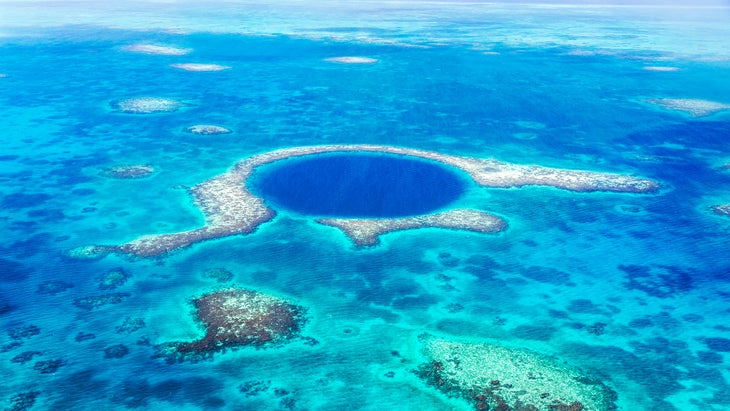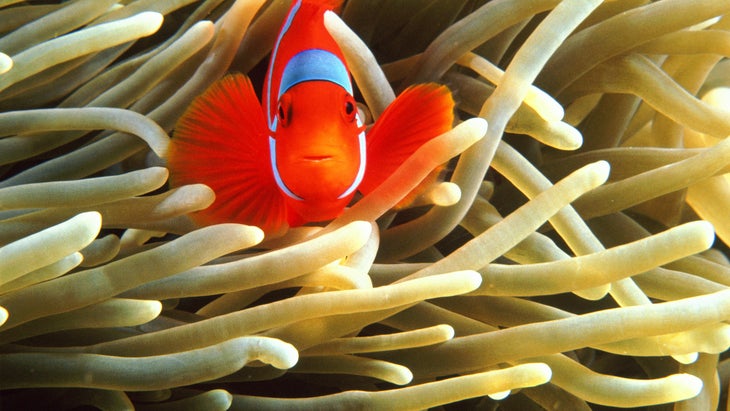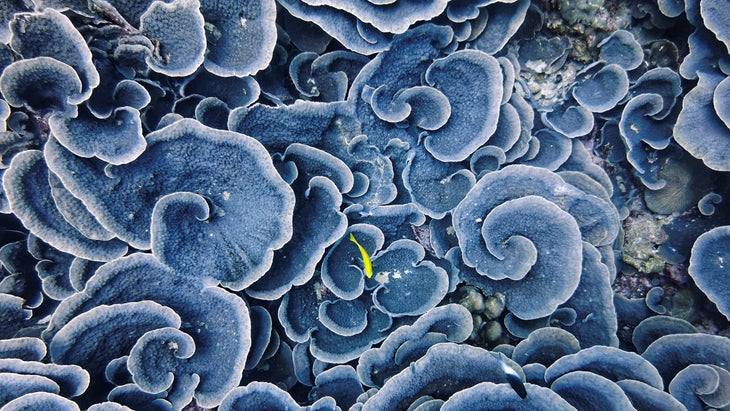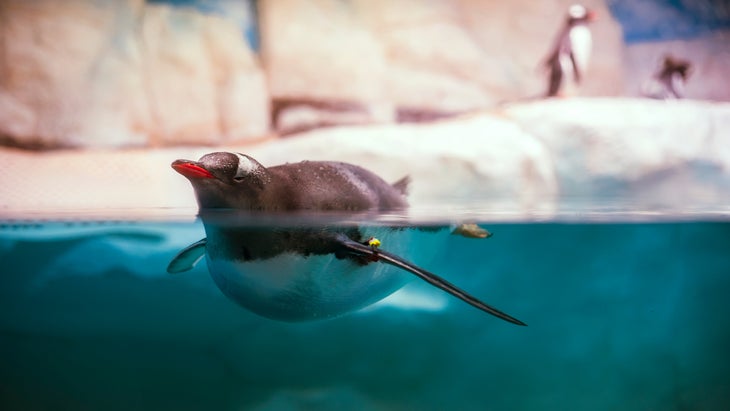Heading out the door? Read this article on the Outside app available now on iOS devices for members!
>”,”name”:”in-content-cta”,”type”:”link”}}”>Download the app.
Every scuba dive starts the same way: Gurgling bubbles and a hissing regulator. Then silence. Signaling “okay” to your buddy, you descend into whatever adventure waits below. After this, there’s no script—nature determines what will come. You’re just the lucky witness. And fortunate you are. A scuba certification is an underwater passport that lets you access some of the best scuba diving in the world. Just like topside travel, you can pick destinations based on what you enjoy most. Some divers swear swimming with a bait ball is the most stunning experience under the sun. You’ll also find others who insist a calm reefscape can’t be beat while others chase the drama of a wall dive.
I’m a kelp woman. To me, the sunbeams of a kelp canopy are holier than any light seeping through cathedral stained glass. I’ve dived around the world and have yet to find anything that beats twirling sea lions and scuttling crabs. Other divers will tell you nothing is worth squeezing into a 7 millimeter wetsuit. More forest for me, I suppose. And, as my family often says: De gustibus non est disputandum—in matters of taste, there can be no disputes. (Though, to be honest, we usually say it with sarcasm about a clearly poor opinion. I have a huffy ‘de gustibus’ ready for anyone who thinks soaring through kelp isn’t worth wearing a hood.)
So, what are you waiting for? The ocean’s ready. Pack your bags, grab your gear, and choose your adventure. The options are endless, but here’s my shortlist to the best scuba diving in the world.
Best Places to Scuba Dive in the U.S.

Monterey, California

California’s Monterey Bay Submarine Canyon is a geography that demands superlatives. The largest undersea canyon on the U.S. West Coast, it’s comparable in size to the Grand Canyon. The slope starts at the shore of the Monterey Peninsula and quickly plummets more than a mile. This is why the Monterey Bay Aquarium constantly releases amazing deep sea footage so often—the deep is their backyard.
It also means divers can access a unique underwater environment in the bay’s sheltered conditions. A swift ascent from the shallows delivers stunning encounters on a shore dive, from massive fried egg jellyfish to hulking mola-molas. Below you, California sea stars slouch in silence. And overhead? The current drives opalescent and the Rainbow nudibranch to wiggle hello at the sea nettles drifting past. You can dance with playful sea lions and marvel at massive kelp—there’s a reason these are called the Sequoias of the Sea.
Don’t Miss: Fried egg jellyfish are easy to spot in the water column, but that doesn’t make the sight of a 2-foot fried egg with tentacles that can stretch to 20 feet any less impressive.
Awesome Dive Adventure: Monterey Expeditions, a outdoors tour company owned and operated by two local divers, runs expeditions to lesser-known spots along the Monterey and Big Sur coast. Private half-day tours include sea lion dives ($199), where you can meet upwards of a dozen resident pinnipeds, and the Canyon and Canopy tour ($299)—a 2-tank kelp forest trip with sightings that can include a mola mola cleaning station and lingcod, followed by a beach grill out.
Conditions, Gear & Training:
🌡️ Water Temps: Up to 65°F from August – October, down to 50°F from December – February
🐠 Visibility: 10 – 50 feet
🤿 Equipment: 7 millimeter (mm) wetsuit with hooded vest and boots minimum; a drysuit is recommended.
🎓 Training: Open Water Diver Certification; drysuit cert if you’re using one
Hawaii

Volcanic fury sculpted these islands, and their handiwork is visible in the blue (after all, the islands are just the portion of the eruptions that broke sea level). Lava tubes—underwater caverns and tunnels—weave through the reef, remnants of its fiery creation. And all around coral explodes in color, a testament to the volcanic soil’s rich nutrients and the deep water’s bounty.
This aquatic Arcadia attracts the underwater glitterati: turtles glide with ancient grace, sharks patrol the edges, whales breach the surface, and dolphins weave through the blue. Even the state fish, the humuhumunukunukuapua’a (or reef triggerfish, for the less tongue-tied), flaunts its vibrant colors.
Don’t Miss: The waters off of Kona boast a resident population of more than 200 oceanic mantas, which have a wingspan that can hit 26 feet. Having dived with these animals in Mexico, I can attest that they are truly awe-inspiring—and you can meet them at night off the shores of Kona. Divers drop into the water shortly after sunset with flashlights, which pull the mantas in to swoop directly overhead as they feed.
Awesome Dive Adventure: Several operators offer after-dark manta encounters, including: Manta Ray Dives of Hawaii (from $170); Big Island Divers (from $149); Kona Honu (from $199 for a 2-tank); Jack’s Diving Locker (from $299 for a 2-tank)
Conditions, Gear & Training:
🌡️ Water Temps: 75°F – 80°F
🐠 Visibility: 50 – 120+ feet
🤿 Equipment: 3 mm
🎓 Training: Open Water Diver Certification
Best Places to Scuba Dive in the Caribbean, and Central and South America

Cozumel, Mexico

Ditch Cancun’s beach clubs for the currents of Cozumel, Mexico where drift dives whisk you to a new world.
Now, don’t let the word ‘drift dive’ scare you. Although the currents at famous sites like the Santa Rosa Wall dictate your dive, it’s like floating along in an underwater lazy river, not a riptide. You get to kick back, breathe deep from your regulator, and watch ocean life hustle by. As you flit through this low-rise coral city, keep your eyes peeled for eagle rays soaring overhead, green turtles flapping by, morays opening wide for cleaner shrimp, nurse sharks resting on the sand, and dozens of fish species dancing around.
Keep your eyes peeled for the endemic splendid toadfish — found only in Cozumel—that has a spiky beard and settles into cracks like a grumpy man on his front-porch rocking chair.
Don’t Miss: Palancar Reef, on the southwest side of the island, is one of the most popular reef systems in the area. Divers can swim through caves and underwater tunnels while keeping their eyes peeled for eagle rays and stingrays.
Awesome Dive Adventure: Dive with Martin offers a 3-day dive package that, in addition to two days of Cozumel reef diving, includes a day of diving the Yucatan Peninsula’s famous cenotes, limestone sinkholes that are essentially underground lakes ($380).
Conditions, Gear & Training:
🌡️ Water Temps: 75°F from December – February; 85°F from June – August
🐠 Visibility: 80 – 100 feet
🤿 Equipment: Rash guard or 3 mm shorty; surface marker buoy (SMB)
🎓 Training: Open Water Diver Certification
Belize

The world’s second-largest barrier reef is a riot of life—nearly 1,400 species call this UNESCO world heritage site home. Green, hawksbill and loggerhead turtles all scuttle around here, as well as angelfish, blennies, seahorses, and parrotfish. They spend their days weaving in and out of a rich tapestry of hard and soft corals that stretches for 190-miles. Shark aficionados will be delighted with the chance to encounter several shark species, including lemon, nurse, and Caribbean reef sharks.
To me, Belize’s real magic arrives after dark. I can never get enough of the sea life that comes out in the light of the moon, especially unfurling octopus and eels with glinting eyes. During my week there, not a night went by without a Caribbean reef squid encounter. One little guy that swam straight into my face, balled his tentacles into fists, and inked me in a fit of pique.
Don’t Miss: The Great Blue Hole—made famous by SCUBA inventor Jacques Cousteau himself—is a 407-foot deep sinkhole in the middle of Lighthouse Reef. The staggering submerged stalactites jut downward into a (seemingly) infinite darkness, making this a one-of-a-kind dive.
Awesome Dive Adventure: Experience the Belize Barrier Reef and hit the Great Blue Hole in just three days with Ambergris Divers (five dives, from $499).
Conditions, Gear & Training:
🌡️ Water Temps: High 70s December – April, low 80s May – November
🐠 Visibility: 40-80+ feet, best April – June
🤿 Equipment: 3mm shorty – 5 mm full wetsuit, depending on personal comfort and number of dives
🎓 Training: A Deep Diver Specialty will allow you to go 130 feet deep, instead of the standard 60 foot limit for an Open Water diver.
Bonaire

You don’t need a boat to do Bonaire. This Dutch Caribbean island, the “Shore Diving Capital of the World,” lets you roll out of bed and into adventure. Vibrant reefs teeming with 470 fish species wait right off the shore—Salt Pier, Alice in Wonderland, Bari Reef, and 1000 Steps, to name a few sites. Rent a truck, go through the drive-through tank fill, and you’re ready to dive.
Dip below the waves and you’re instantly transported. Tarpon streak past, eels slither from their dens, stingrays glide like phantoms. Turtles—hawksbill and green—cruise serenely, while playful dolphins weave through the blue. Keep your eyes peeled, you might spot a frogfish camouflaged amongst the coral, a seahorse clinging to a swaying fan, or even a pygmy goby, smaller than your fingernail. Disappointment is as rare as a bad day in paradise when you can spot more than 100 species on a single dive.
Don’t Miss: Turtle lovers rejoice – this is a great place to meet your flippered friend on their turf. Hawksbill and green turtles live near the island year round, and lucky divers can encounter loggerhead turtles from April to December.
Awesome Dive Adventure: Get the full Bonaire experience with Buddy Dive’s week-long Drive and Dive package, which includes a car rental, accommodations, unlimited shore diving, six boat dives, and more (from $1,256).
Conditions, Gear & Training:
🌡️ Water Temps: 78°F – 84°F
🐠 Visibility: 100 – 150 feet
🤿 Equipment: Rash guard or 3 mm
🎓 Training: Open Water Diver Certification
Galapagos Islands, Ecuador

This world-famous chain of 13 islands is nestled 600 miles from mainland Ecuador. Divers who make the crossing get a view of the islands even Darwin didn’t experience during his formative five-week stint here. (I wonder how the sight of hundreds of hammerheads bustling beneath the HMS Beagle would have shaped his theory of evolution—talk about a plot twist.)
These waters are stocked with once-in-a-lifetime encounters: One in five marine animals is endemic, meaning they are found nowhere else in the world. This includes the world’s only marine iguanas—which forage underwater for sea algae—and tropical penguins. Plenty of large animals live here as well, setting the stage for incredible encounters, including Galapagos and hammerhead sharks, and whale sharks (the world’s largest fish, which top out longer than a school bus).
Don’t Miss: Hammerhead sharks are the only shark species that schools, and hundreds of scalloped hammerheads aggregate at a time in the Galapagos Marine Reserve. While they live there year-round, they are most abundant in January around Darwin and Wolf Islands.
Awesome Dive Adventure: Spend an entire week diving the islands aboard the Galapagos Aggressor III, a 16-passenger scuba yacht that offers up to four dives a day and two land excursions during the trip. (From $7,100; $100 for nitrox). And, fun fact, passengers on this boat witnessed the Darwin Arch collapse in real time when it crumbled in 2021.
Conditions, Gear & Training:
🌡️ Water Temps: Highly variable. 62°F – 68°F from June – December; 70°F – 82°F from December – May
🐠 Visibility: 10 – 70 feet
🤿 Equipment: 7 mm wetsuit, hood, boots, gloves, SMB, marine rescue GPS
🎓 Training: Advanced Open Water Diver Certification recommended to be better equipped for local conditions, which can be challenging
Best Places to Scuba Dive in Asia and Oceania

Indonesia

Variety is the name of the game in Indo. Whether you want to dive a reef or a wall, see a wreck or encounter endemics, catch a drift or search through muck, you can do it here.
This immense archipelago is the epicenter of the Coral Triangle, a global hotspot of marine biodiversity, and home to some of the best scuba diving in the world. Divers can encounter a dazzling array of sea creatures, massive manta rays and impossibly tiny pygmy seahorses, the bizarre mola mola, the deceptive Rhinopias, the gelatinous cuttlefish, and the mimic octopus, just to name a few.
And that’s before you consider the wreck diving. Due to its strategic location in the Pacific during World War II, these waters were a major battle ground. The remnants of this conflict lie scattered on the ocean floor, including USAT Liberty, Emma Miller, and Spiegel Estate.
Don’t Miss: Here’s my one topside tip—Komodo dragons can only be seen in Indonesia, so don’t miss your chance. Visit Komodo National Park on Komodo Island to see these fascinating lizards live before you hit the deep sea.
Awesome Dive Adventure: Sail in style on the Arenui, a luxury wooden ship with spa, outdoor dining, and more staff than guests. Itineraries shift throughout the year depending on the season. (From $4,760 for 7 nights.)
Conditions, Gear & Training:
🌡️ Water Temps: 82°F – 84°F
🐠 Visibility: 30 – 60 feet
🤿 Equipment: 3 mm; reef hook; SMB
🎓 Training: Open Water Diver Certification
Sabah, Malaysia

Sipadan’s a riot, a swirling, fish-drunk mess that’ll leave you reeling. Walls of coral tumble from this small inland into the impossibly blue, teeming with so many turtles they cause traffic jams. Schools of jackfish swirl like underwater tornadoes, thousands strong, parting to reveal patrolling sharks. Then there’s the muck, the weird stuff—frogfish, seahorses, and other minute creatures. It’s Barracuda Point, though, that’s the main event. A whirlwind of teeth and scales, these fish frenzies hypnotize even the most seasoned scuba divers.
Across the channel, Mabul and Kapalai offer a different dance, a quieter ballet of the bizarre. Dive down to the sandy havens, where flamboyant cuttlefish strut their chromatic wares, and flamboyant cuttlefish wannabes, the mimic octopus, put on their one-man shows. Torchlight reveals the otherworldly: bobbing nudibranchs in fluorescent hues, and the toothy grin of a moray eel peeking from its coral castle. It’s a land of the strange and the small, a microcosm of wonder waiting to be unraveled, one seadragon swirl at a time.
Don’t Miss: Barracuda Point is the show stopper here. Where else will turn your head with a tornado of teeth?
Awesome Dive Adventure: Advanced divers can snag a coveted Sipadan permit through their chosen dive operator. These permits (178 daily) are limited to conserve the ecosystem. It’s advised that you stay for at least four days to get a dive day in. Scuba Junkie Sipadan guarantees a permit for 3 day, 2 night bookings (from $468)—the other days are spent diving Mabul and Kapali.
Conditions, Gear & Training:
🌡️ Water Temps: 78°F – 84°F
🐠 Visibility: 30 – 80 feet
🤿 Equipment: 3 mm; reef hook; SMB
🎓 Certification: Advanced Open Water Certification required
Great Barrier Reef, Australia

This is no aquarium. So large it’s visible from space, the Great Barrier Reef is the beating heart of the ocean, wild and unforgettable. You could spend a lifetime scuba diving here and still not see it all.
Vibrant coral unspool beneath your fins, teeming with fish that swirl and flash like neon confetti. Turtles cruise with the calm of ancient mariners, sharks sleek and curious. Then there’s the big stuff: the manta rays, whale sharks, and dugongs. And if you’re lucky between November and March, maybe, just maybe, you’ll time it right and see a coral spawning—an underwater blizzard of life beginning anew.
Don’t Miss: Mike Ball Dive Expeditions offers liveaboard itineraries that overlap with coral spawning, though the experience is not guaranteed. Coral typically spawn between the 2nd and 6th day of the November full moon when the water has been north of 80 degrees for a month, a date that can shift with water temperatures. (I promise that’s real science, not a horoscope.) Contact Mike Ball to see which itinerary is expected to line up with the upcoming spawning.
Awesome Dive Adventure: Fin through the Coral Greenhouse, the world’s largest underwater structure, at the Museum of Underwater Art—one of dozens of installations in Queensland’s submerged gallery crafted by underwater artist Jason deCaires Taylor. ($390 adult, $340 children; departs from Townsville and Magnetic Island)
Conditions, Gear & Training:
🌡️ Water Temps: Low of 68°F June – August; High around 84°F December – February
🐠 Visibility: 30 – 100 feet
🤿 Equipment: 3 – 5 mm
🎓 Training: Open Water Diver Certification
Best Places to Scuba Dive in the Indian Ocean

Maldives

There are more dives than islands in the Maldives—and that’s saying something in a country stitched together across more than 1,100 islands. Whether you crave drift dives through vibrant coral gardens, adrenaline-pumping pinnacles, or the eerie allure of wrecks, this scattered paradise caters to every diver’s whim.
Pelagic lovers will be delighted by the wide variety here, from tiger sharks to manta rays, mola molas to barracudas. Drift dives generally offer the best opportunities to encounter these big animals, as the currents bring in nutrients that pull them in from the blue. South Ari Atoll is known for its drift adventures; other spots with awe-inspiring big animal encounters include the cleaning station at Lankan Manta Point in the Malé Atoll and Hammerhead Point in the Rasdhoo Atoll. Photographers will delight in the candyland that’s Rainbow Reef, which bustles between islands in the Malé Atoll.
Don’t Miss: Whale sharks, the world’s largest fish, live in the Maldives year-round. Growing up to 40 feet in length, this is an encounter many divers chase for years—and happens pretty much every day at South Ari Atoll.
Awesome Dive Adventure: Contribute to whale shark research when you spend 11 days aboard the M/V Felicity, swimming with whale sharks to collect data for the Maldives Whale Shark Research Programme (From $3,038).
Conditions, Gear & Training:
🌡️ Water Temps: 80°F – 86°
🐠 Visibility: 30 – 100 feet
🤿 Equipment: 3 mm; reef hook; SMB
🎓 Training: Open Water Diver Certification
Seychelles

Forget the overfished reefs and crowded coral walkways. Nestled at the intersection of the Indian Ocean, the Arabian Sea, and the Somali Current, the Seychelles offers solitude on land and vivid adventure below.
Here, the vibrant hues of coral gardens rival any rainforest canopy. These healthy reefs —protected by the country’s unwavering commitment to conservation — teem with biodiversity. Silent giants like manta rays and whale sharks soar through technicolor depths. Reef sharks patrol their claim with quiet purpose, while more than 20 species of playful dolphins weave between divers, their curiosity as boundless as the ocean itself. Layer turtles, eels, batfish, yellow snapper and another 1,000-or-so fish across this aquatic city, and you have more than enough beauty to last you a lifetime.
Don’t Miss: Keep your eyes peeled for nudibranchs—these minute and stunning sea slugs that come in every hue and shape imaginable. Orange polka dots with purple ruffles? Sure. Zebra striped with yellow splotches? You got it. With hundreds of different species in the Seychelles seas, these sands are a slug circus.
Awesome Dive Adventure: Explore as you like with Dive Explorer Seychelles, which offers everything from a 3-tank, choose your own adventure day ($520.50) to a 7-day, 21-dive liveaboard that lets you taste everything the islands have to offer ($3,567).
Conditions, Gear & Training:
🌡️ Water Temps: Low of 77°F from June to September; highs around 84°F April – May and October – November
🐠 Visibility: 30 – 100 feet
🤿 Equipment: Rash guard or 3mm
🎓 Training: Open Water Diver Certification
Best Place to Scuba Dive in the Southern Ocean

Antarctica

A certain breed of divers itches for ice. If that’s you, the fractured ice shelves of Antarctica will be Eden.
Unlike the brazen hues of coral, the palette here is stark—glacial blues, inky blacks, the occasional flash of silver. With patience and luck, action ruptures the stillness: Gentoo penguins rocket past in a black and white ballet before colossal leopard seals glide with alien grace, their yellowed eyes locked on yours.
Spring unveils a feast. Krill, the lifeblood of the Southern Ocean, paints the water a cloudy red. This bounty draws colossal whales, their mournful songs echoing through the water column.
It’s a world usually untouched that radiates with untamed power. And it’s not for the faint of heart, but for those who dare, it etches the soul.
Don’t Miss: Encountering a leopard shark is far from guaranteed, but meeting this apex predator in their natural habitat is to encounter unbridled energy.
Awesome Dive Adventure: Add diving to your Oceanwide Polar Circle and Antarctic Peninsula cruise itinerary, which traverses waters traveled by Humpback, Minke, and Fin whales. (From $5,450 for the cruise, plus $815 to add dive excursions; 30 drysuit dives required to book dives)
Conditions, Gear & Training:
🌡️ Water Temps: Mid 20s to mid 30s °F
🐠 Visibility: 40 to 100 feet, excluding plankton blooms
🤿 Equipment: Drysuit; heated vest; hood; gloves; boots; ice-rated regulator
🎓 Certifications: Ice diving required and rescue diver training recommended

Life was never the same after getting dive certified in the 54°F waters of a flooded Ohio quarry. Local diving led Alexandra Gillespie to a globetrotting stint taking dozens of dives in cool places and writing about them afterward. Now a freelancer for Outside, she covers water and travel. Her writing has also appeared in NPR, National Geographic, Scuba Diving, and other national outlets.



